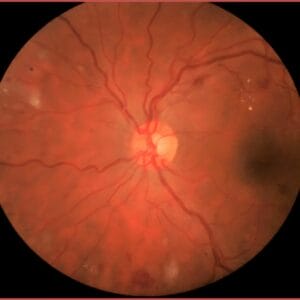June 20, 2023
Given that heart disease is the number one cause of death in the United States, the timeless wisdom of the adage “you are what you eat” remains as relevant today as ever.1 While various factors contribute to dry eye development, research suggests that nutrition plays a significant role, especially for those over age 45. While it may seem easy to overcomplicate dry eye disease, focusing on the fundamentals and establishing a strong nutritional foundation can lead to improved outcomes for our patients. Here is how nutrition can impact dry eye and the key dietary components that can promote ocular health and potentially alleviate dry eye symptoms.
Hydration and Water Intake
Proper hydration is essential for maintaining ocular health, and dehydration can lead to dryness throughout the body, including the eyes. Staying adequately hydrated by consuming enough water throughout the day helps ensure sufficient tear production. A general guideline is to drink at least eight glasses of water per day. However, individual needs may vary based on factors such as climate, physical activity, and overall health.
Omega Fatty Acids
Omega fatty acids, particularly eicosapentaenoic acid (EPA) and docosahexaenoic acid (DHA), are known for their anti-inflammatory properties and have been associated with improved eye health. A meta-analysis of 17 clinical trials published in Cornea found that a higher intake of omega-3 fatty acids, typically found in fatty fish such as salmon, tuna, and mackerel, significantly improves dry eye symptoms and signs in patients with dry eye disease.2 These healthy fats help maintain the integrity of the meibomian glands, preventing excessive evaporation and improving tear film stability.
Oral omega fatty acids, especially ones with gamma-linolenic acid (GLA), improve markers of inflammation and inflammatory mediators in dry eye disease. GLA is the precursor of an anti-inflammatory prostaglandin, PGE1, which is found in the tears, lacrimal gland, and conjunctiva.3,4
GLA may reduce inflammation in other systemic diseases such as rheumatoid arthritis, irritable bowel syndrome, and diabetic retinopathy, possibly by acting on T-cells to modulate the immune response. In some omegas, 2,000-3,000 mg. are typically required to have a significant effect. In contrast, 235 mg of GLA significantly reduced two different inflammatory markers in a clinical trial.5
Antioxidants and Vitamins
Antioxidants, such as vitamins A, C, and E, play a crucial role in protecting the eyes from oxidative stress. These nutrients help combat inflammation, neutralize harmful free radicals, and promote a healthy tear film. Foods rich in antioxidants include colorful fruits and vegetables such as berries, citrus fruits, leafy greens, and carrots.
Vitamin A is vital for corneal and conjunctival epithelial cell health. It is necessary for goblet cell and lacrimal gland production of a variety of mucins in the tear film.6 Sources of vitamin A are red, orange, yellow, and dark green leafy vegetables.
Vitamin B6 is needed for the neuronal blink response7 and is one of the nutrient cofactors needed to push the metabolic pathway conversion of GLA to dihomo-gamma-linolenic acid (DGLA).8,9 Sources of vitamin B6 are nuts, bananas, and beans.
Vitamin B12 is involved in the metabolism of every cell of the human body and is a cofactor in DNA synthesis, and fatty acid and amino acid metabolism. Sources of vitamin B12 are fish, meat, poultry, eggs, milk, clams, sardines, and tuna.10
Vitamin C as ascorbyl palmitate (fat-soluble form) modulates PGE1 synthesis. This type of vitamin C enhances the production of IgE concentrates in tears, the first line of basophil and mast cell defense against invading pathogens and allergens that frequently cause dry eye symptoms. Citrus is one of the sources of vitamin C.11
Vitamin D improves tear hyperosmolarity12,13 and should be included in all formulations that include vitamin A due to an increased risk of fractures in individuals over 45 taking large amounts of supplemental vitamin A. However, up to 50% of the world’s population may not get enough sun, and 40% of U.S. residents are deficient in vitamin D.14,15 Sources of vitamin D are salmon, herring, sardines, canned tuna, oysters, shrimp, egg yolks, and mushrooms.
The Impact of Diet on Inflammation
Chronic inflammation can contribute to the development and progression of dry eye. Certain dietary choices can either promote or reduce inflammation in the body, including the eyes. Diets rich in processed foods, refined sugars, and unhealthy fats can exacerbate inflammation, while anti-inflammatory diets that emphasize whole foods, lean proteins, healthy fats, and plenty of fruits and vegetables can help alleviate inflammation and potentially improve dry eye symptoms.
Although nutrition is just one piece of the puzzle in managing dry eye, it plays a crucial role in supporting ocular health and reducing inflammation. Omega fatty acids, antioxidants, vitamins, and staying hydrated are essential components of a well-rounded diet that can potentially alleviate dry eye symptoms. Discussing the nutritional benefits with your patients can go a long way and provide many benefits for your patients.
References
1 Centers for Disease Control and Prevention. Leading Causes of Death
2 Magno, Morten Schjerven*,†,‡; Utheim, Tor P. PhD*,§; Morthen, Mathias Kaurstad*,‡; Snieder, Harold PhD¶; Jansonius, Nomdo M. PhD‡; Hammond, Christopher J. MD‖,**; Vehof, Jelle PhD††,‡‡,§§. The Relationship Between Caffeine Intake and Dry Eye Disease. Cornea 42(2):p 186-193, February 2023. | DOI: 10.1097/ICO.0000000000002979
3 Viau, Sabrina, et al. Efficacy of a 2-month dietary supplementation with polyunsaturated fatty acids in dry eye induced by scopolamine in a rat mode. Graefe’s Arch Clin Exp Ophthalmol 247.8 (2009): 1039-1050.
4 Aragona, Pasquale, et al. Systemic omega-6 essential fatty acid treatment and pge1 tear content in Sjögren’s syndrome patients. Invest Ophthalm Vis Sci 46.12 (2005): 4474.
5 Personal communication 2016, Zac Denning, ScienceBased Health
6 Odaka A, Toshida H, Ohta T, et al. Efficacy of retinol palmitate eye drops for dry eye in rabbits with lacrimal gland resection. Clin Ophthalmol. 2012;6:1585-93.
7 Horrobin DF. Essential fatty acid and prostaglandin metabolism in Sjögren’s syndrome, systemic sclerosis and rheumatoid arthritis. Scand J Rheumatol Suppl. 1986;61:242-5.
8 Bordoni A, Hrelia S, Lorenzini A, et al. Dual influence of aging and vitamin B6 deficiency on delta-6-desaturation of essential fatty acids in rat liver microsomes. Prostaglandins Leukot Essent Fatty Acids. 1998 Jun;58(6):417-20.
9 Berman BD, Horovitz SG, Morel B, Hallett M. Neural correlates of blink suppression and the buildup of a natural bodily urge. Neuroimage. 2012 Jan 16;59(2):1441-50.
10 Yamada K (2013). “Chapter 9. Cobalt: Its Role in Health and Disease”. In Sigel A, Sigel H, Sigel RK. Interrelations between Essential Metal Ions and Human Diseases. Metal Ions in Life Sciences.
11 Horrobin DF, Campbell A. Sjögren’s syndrome and the sicca syndrome: the role of prostaglandin E1 deficiency. Treatment with essential fatty acids and vitamin C. Med Hypotheses. 1980 Mar;6(3):225-32.
12 Bosetti M, Sabbatini M, Calarco A, et al. Effect of retinoic acid and vitamin D3 on osteoblast differentiation and activity in aging. J Bone Miner Metab. 2016 Jan;34(1):65-78.
13 Kizilgul M, Kan S, Ozcelik O, et al. Vitamin D replacement improves tear osmolarity in patients with vitamin D deficiency. Semin Ophthalmol. 2018;33(5):589-594.
14 Haq A, Svobodová, Imran S, et al. Vitamin D deficiency: A single centre analysis of patients from 136 countries. J Steroid Biochem Mol Biol. 2016 Nov;164:209-213. doi: 10.1016/j.jsbmb.2016.02.007. Epub 2016 Feb 11.
15 Forrest KY, Stuhldreher WL. Prevalence and correlates of vitamin D deficiency in US adults. Nutr Res. 2011 Jan;31(1):48-54. doi: 10.1016/j.nutres.2010.12.001.





